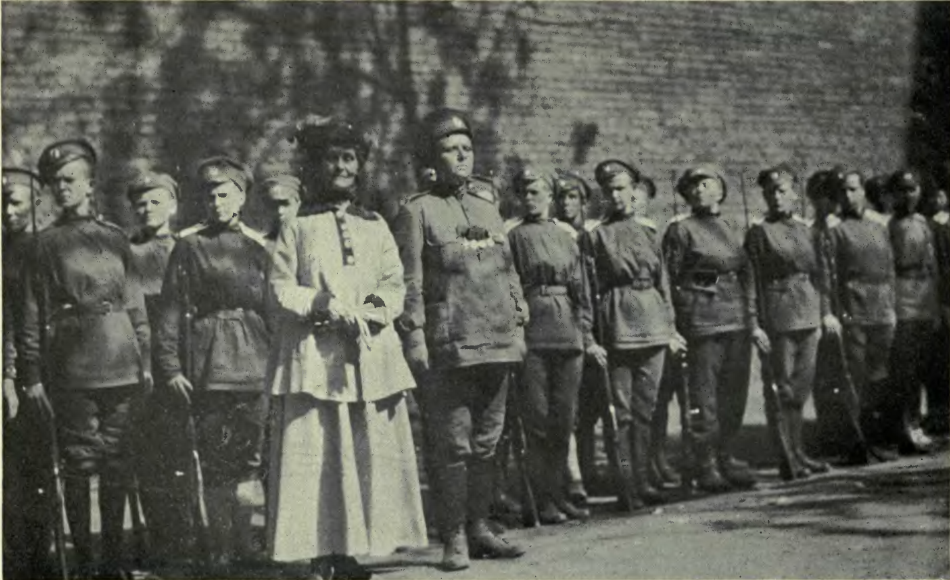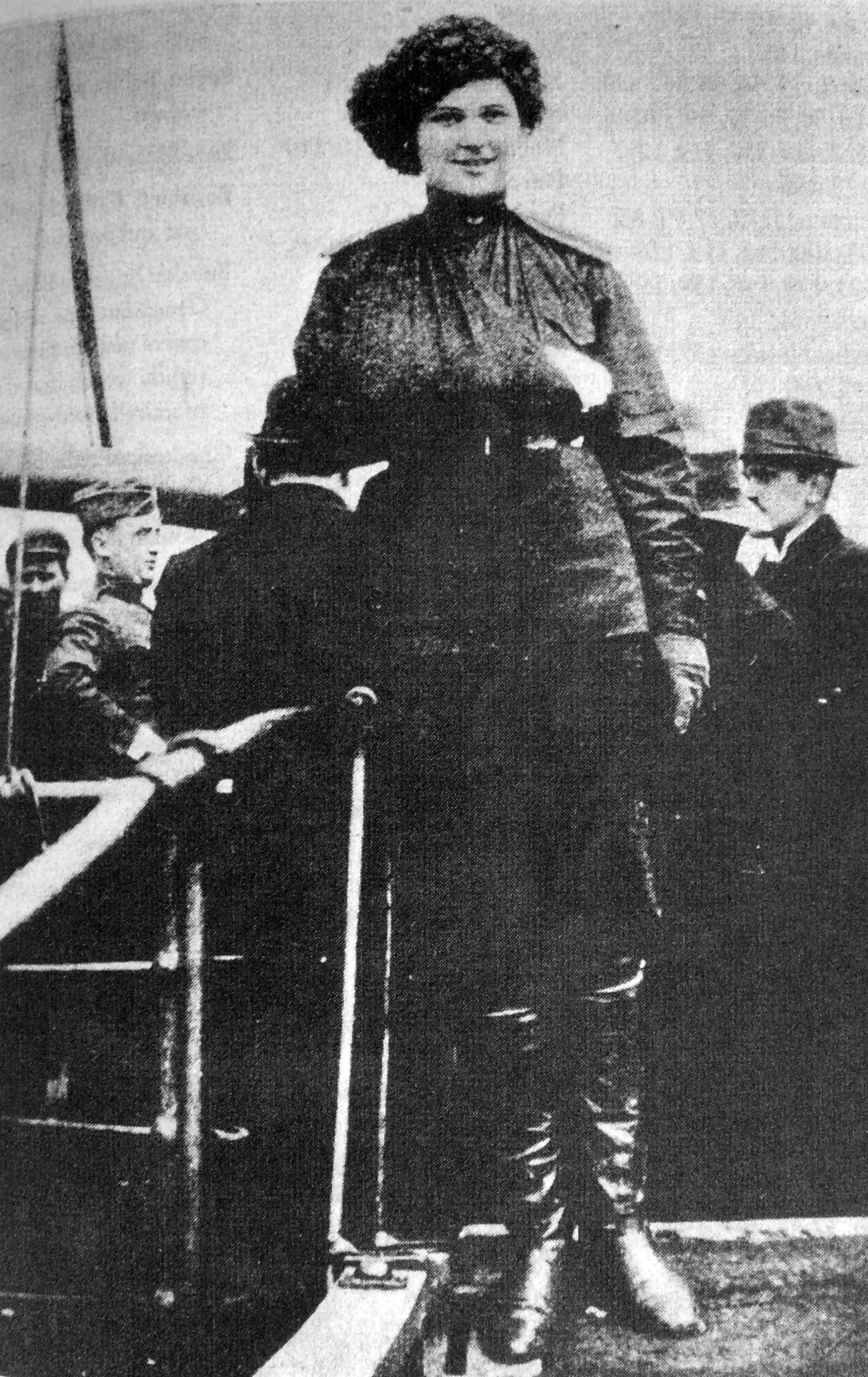|
Women's Battalion
Women's Battalions (Russia) were all-female combat units formed after the February Revolution by the Russian Provisional Government, in a last-ditch effort to inspire the mass of war-weary soldiers to continue fighting in World War I. In the spring of 1917, the Russian Ministry of War authorized the creation of sixteen separate all-female military formations. Four were designated as infantry battalions, eleven slated as communications detachments and a singular naval unit. Already some women had successfully petitioned to join regular military units, and with the planning of the Kerensky Offensive, a number began pressing the new Provisional Government to create special women's battalions.Stoff 2006, p. 114. These women, along with a number of high-ranking members of the Russian government and military administration, believed that female soldiers would have significant propaganda value, their example revitalizing the weary and demoralized men of the Russian army.Stoff 2006, p. 6 ... [...More Info...] [...Related Items...] OR: [Wikipedia] [Google] [Baidu] |
Maria Bochkareva
Maria Leontievna Bochkareva (July 1889 – 16 May 1920; russian: Мари́я Лео́нтьевна Бочкарёва, Maria Leontievna Bochkareva, née ''Frolkova'' (Фролко́ва), nicknamed ''Yashka'') was a Russian soldier who fought in World War I and formed the 1st Russian Women's Battalion of Death. She was the first Russian woman to command a military unit. Early life Maria Frolkova was born to a peasant family in Nikolskoye in July 1889. Her father was a sergeant in the imperial army who fought in the Russo-Turkish War. She left home at sixteen to marry Afanasy Bochkarev. They moved to Tomsk, Siberia, where they worked as labourers. Her husband abused her, causing her to leave him. She found a job as a servant to employers who coerced her into working in their brothel. They moved her to Sretensk where Maria began a relationship with a local Jewish man named Yakov (or Yankel) Buk. She and Buk opened a butcher shop, but in May 1912 Buk was arrested for larceny and ... [...More Info...] [...Related Items...] OR: [Wikipedia] [Google] [Baidu] |
Russian Provisional Government
The Russian Provisional Government ( rus, Временное правительство России, Vremennoye pravitel'stvo Rossii) was a provisional government of the Russian Republic, announced two days before and established immediately after the abdication of Nicholas II. The intention of the provisional government was the organization of elections to the Russian Constituent Assembly and its convention. The provisional government, led first by Prince Georgy Lvov and then by Alexander Kerensky, lasted approximately eight months, and ceased to exist when the Bolsheviks gained power in the October Revolution in October N.S.">Old_Style_and_New_Style_dates.html" ;"title="ovember, Old Style and New Style dates">N.S.1917. According to Harold Whitmore Williams, the history of the eight months during which Russia was ruled by the Provisional Government was the history of the steady and systematic disorganization of the army. For most of the life of the Provisional Government ... [...More Info...] [...Related Items...] OR: [Wikipedia] [Google] [Baidu] |
Military Units And Formations Of Russia In World War I
A military, also known collectively as armed forces, is a heavily armed, highly organized force primarily intended for warfare. It is typically authorized and maintained by a sovereign state, with its members identifiable by their distinct military uniform. It may consist of one or more military branches such as an army, navy, air force, space force, marines, or coast guard. The main task of the military is usually defined as defence of the state and its interests against external armed threats. In broad usage, the terms ''armed forces'' and ''military'' are often treated as synonymous, although in technical usage a distinction is sometimes made in which a country's armed forces may include both its military and other paramilitary forces. There are various forms of irregular military forces, not belonging to a recognized state; though they share many attributes with regular military forces, they are less often referred to as simply ''military''. A nation's military may f ... [...More Info...] [...Related Items...] OR: [Wikipedia] [Google] [Baidu] |
Battalions Of Russia
A battalion is a military unit, typically consisting of 300 to 1,200 soldiers commanded by a lieutenant colonel, and subdivided into a number of companies (usually each commanded by a major or a captain). In some countries, battalions are exclusively infantry, while in others battalions are unit-level organizations. The word battalion came into the English language in the 16th century from the French language ( French: ''bataillon'' meaning "battle squadron"; Italian: ''battaglione'' meaning the same thing; derived from the Vulgar Latin word ''battalia'' meaning "battle" and from the Latin word ''bauttere'' meaning "to beat" or "to strike"). The first use of the word in English was in the 1580s. Description A battalion comprises two or more primary mission companies which are often of a common type (e.g., infantry, tank, or maintenance), although there are exceptions such as combined arms battalions in the U.S. Army. In addition to the primary mission companies, a batt ... [...More Info...] [...Related Items...] OR: [Wikipedia] [Google] [Baidu] |
Marina Yurlova
Marina Yurlova (russian: Мари́на Максимилиа́новна Ю́рлова; 25 February 1900 - 1 April 1984) was a Russian child soldier and author. She fought in World War I and later in the Russian Civil War on the side of the anti-communist White movement. Wounded several times, she won the Russian Cross of Saint George for bravery three times. She eventually made her way to Vladivostok, then to Japan and finally to the USA, where she performed as a dancer. Yurlova published her autobiography in three parts: ''Cossack Girl'' (1934, republished in 2010), ''Russia Farewell'' (1936) and ''The Only Woman'' (1937). Biography She was born in Raevskaya, a small village near Krasnodar. The daughter of a colonel of the Kuban Cossacks, she was just 14 years old when her father went to war in August 1914. Caught up in the adventure and tradition of Cossack women following their men to the front, she became a child soldier in the Russian army at age 14. Specifically, she ... [...More Info...] [...Related Items...] OR: [Wikipedia] [Google] [Baidu] |
Isaac Don Levine
Isaac Don Levine (January 19, 1892 – February 15, 1981) was a 20th-century Russian-born American journalist and anticommunist writer, who is known as a specialist on the Soviet Union. He worked with Soviet ex-spy Walter Krivitsky in a 1939 expose of Stalin's purges and other terrorism in the Soviet Union. Later he worked with Whittaker Chambers, a defector from the American Communist Party, to reveal agents in the United States government. Background Levine was born in 1892 in Mazyr (then "Mozyr"), Belarus, into a Zionist Jewish family. He immigrated to the United States in 1911, where he learned English. He finished high school in Missouri. Career Levine found work with ''The Kansas City Star'' and later ''The New York Tribune'', for which he covered the revolution of 1917. He would return to Russia in the early 1920s to cover the Civil War for ''The Chicago Daily News''. He was in Boston to cover the Sacco and Vanzetti trials in the early 1920s, during which he formed t ... [...More Info...] [...Related Items...] OR: [Wikipedia] [Google] [Baidu] |
Maria Bochkareva
Maria Leontievna Bochkareva (July 1889 – 16 May 1920; russian: Мари́я Лео́нтьевна Бочкарёва, Maria Leontievna Bochkareva, née ''Frolkova'' (Фролко́ва), nicknamed ''Yashka'') was a Russian soldier who fought in World War I and formed the 1st Russian Women's Battalion of Death. She was the first Russian woman to command a military unit. Early life Maria Frolkova was born to a peasant family in Nikolskoye in July 1889. Her father was a sergeant in the imperial army who fought in the Russo-Turkish War. She left home at sixteen to marry Afanasy Bochkarev. They moved to Tomsk, Siberia, where they worked as labourers. Her husband abused her, causing her to leave him. She found a job as a servant to employers who coerced her into working in their brothel. They moved her to Sretensk where Maria began a relationship with a local Jewish man named Yakov (or Yankel) Buk. She and Buk opened a butcher shop, but in May 1912 Buk was arrested for larceny and ... [...More Info...] [...Related Items...] OR: [Wikipedia] [Google] [Baidu] |
February Revolution
The February Revolution ( rus, Февра́льская револю́ция, r=Fevral'skaya revolyutsiya, p=fʲɪvˈralʲskəjə rʲɪvɐˈlʲutsɨjə), known in Soviet historiography as the February Bourgeois Democratic Revolution and sometimes as the March Revolution, was the first of two revolutions which took place in Russia in 1917. The main events of the revolution took place in and near Petrograd (present-day Saint Petersburg), the then-capital of Russia, where long-standing discontent with the monarchy erupted into mass protests against food rationing on 23 February Old Style (8 March New Style). Revolutionary activity lasted about eight days, involving mass demonstrations and violent armed clashes with police and gendarmes, the last loyal forces of the Russian monarchy. On 27 February O.S. (12 March N.S.) the forces of the capital's garrison sided with the revolutionaries. Three days later Tsar Nicholas II abdicated, ending Romanov dynastic rule and the Russian Empi ... [...More Info...] [...Related Items...] OR: [Wikipedia] [Google] [Baidu] |



